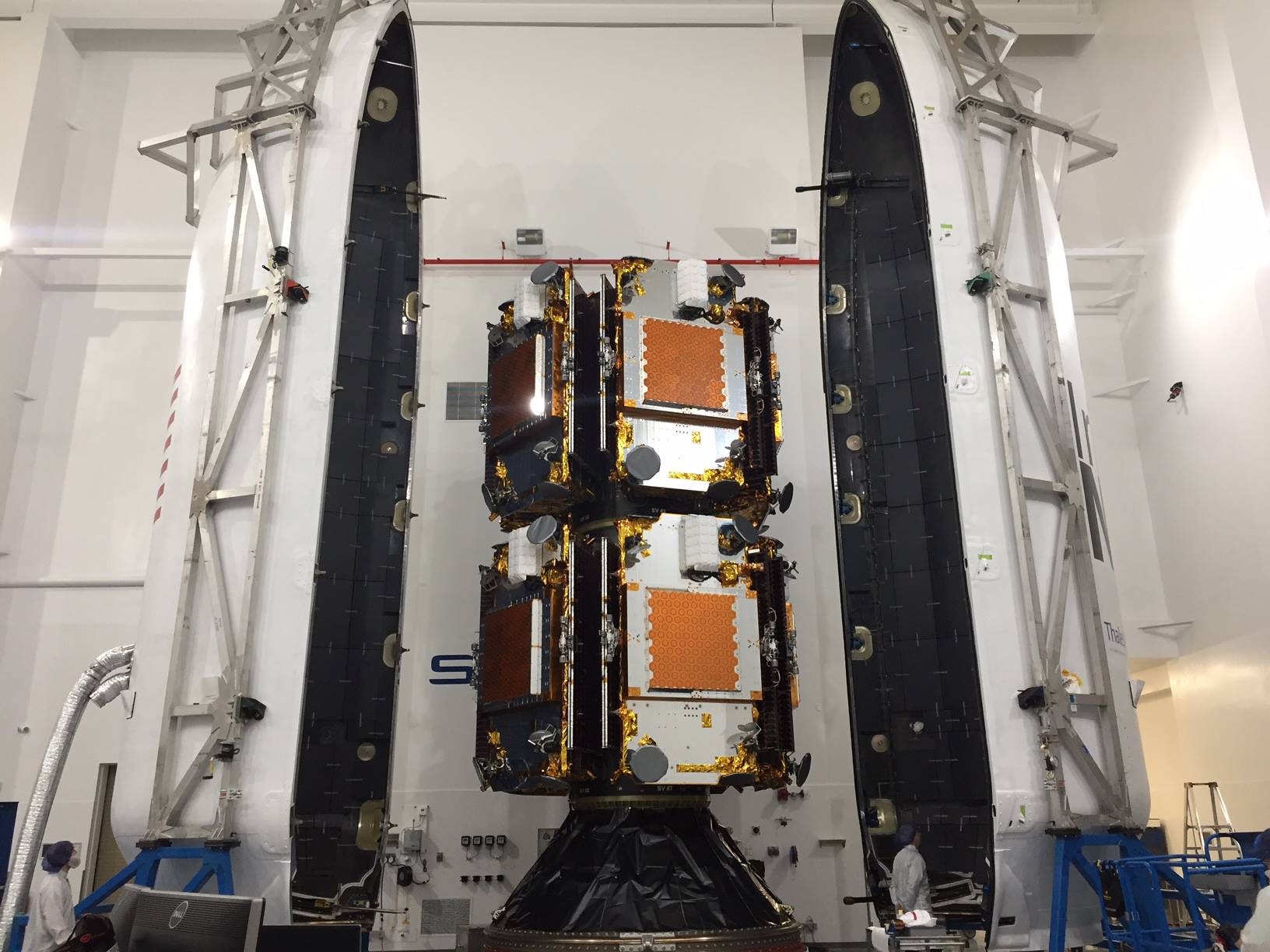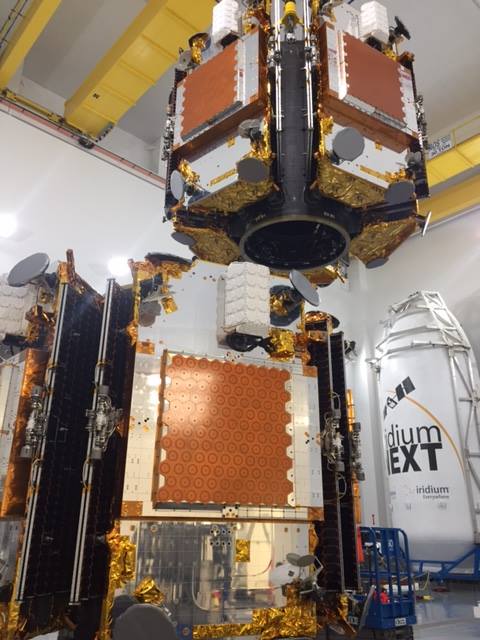
The first ten IridiumNEXT satellites are stacked and encapsulated in the Falcon 9 fairing for a Jan. 8 launch attempt from Vandenberg AFB, CA. Photo Credit: Iridium
SpaceX is aiming to return their workhorse Falcon-9 rocket to flight next Sunday with a fleet of 10 Iridium NEXT satellites. The mission, currently scheduled to lift-off on Jan. 8 at 10:28 a.m. Pacific Time from Space Launch Complex 4E at Vandenberg Air Force Base, Calif., will mark SpaceX’s 30th Falcon-9 and the first launch for SpaceX since a Sept. 1 explosion took out their rocket, Cape Canaveral launch complex, and their customer’s AMOS-6 satellite.
The 10 satellites flying next weekend represent the first set of 70 total that Iridium is launching with SpaceX to replace their current constellation; all of which are contracted to fly on seven Falcon-9 launches over the next 18 months (prior to the AMOS-6 accident, Iridium wanted all their launches flown by the end of 2017).

The first ten IridiumNEXT satellites being stacked for flight atop a SpaceX Falcon 9 rocket for a Jan. 8 launch attempt at 10:28am Pacific time. Photo Credit: Iridium
A landing attempt of the Falcon-9 booster will occur far offshore minutes after launch, using the company’s autonomous “Just Read The Instructions” drone ship as a landing pad.
In the time since the Sep. 1 explosion, the accident investigation has focused heavily on a breach in the cryogenic helium system of the rocket’s second stage liquid oxygen tank, with special attention narrowed to one of the three composite over wrapped pressure vessels (COPVs) inside the LOX tank.
Having worked with numerous agencies, including NASA, the FAA, U.S. Air Force and NTSB, the Hawthorne, Calif.-based company today released final results of the investigation, as well as outlined some of the actions they intend to take moving forward to prevent another AMOS-6 incident from happening again.
———————————————————————
Over the past four months, officials at the Federal Aviation Administration (FAA), the U.S. Air Force (USAF), the National Aeronautics and Space Administration (NASA), the National Transportation Safety Board (NTSB), along with several industry experts, have collaborated with SpaceX on a rigorous investigation to determine the cause of the anomaly that occurred September 1 at Space Launch Complex 40 (SLC-40) at Cape Canaveral Air Force Station in Florida. This investigation team was established according to SpaceX’s accident investigation plan as approved by the FAA. As the primary federal licensing body, the FAA provided oversight and coordination for the investigation.
Investigators scoured more than 3,000 channels of video and telemetry data covering a very brief timeline of events – there were just 93 milliseconds from the first sign of anomalous data to the loss of the second stage, followed by loss of the vehicle. Because the failure occurred on the ground, investigators were also able to review umbilical data, ground-based video, and physical debris. To validate investigation analysis and findings, SpaceX conducted a wide range of tests at its facilities in Hawthorne, California and McGregor, Texas.
The accident investigation team worked systematically through an extensive fault tree analysis and concluded that one of the three composite overwrapped pressure vessels (COPVs) inside the second stage liquid oxygen (LOX) tank failed. Specifically, the investigation team concluded the failure was likely due to the accumulation of oxygen between the COPV liner and overwrap in a void or a buckle in the liner, leading to ignition and the subsequent failure of the COPV.
Each stage of Falcon 9 uses COPVs to store cold helium which is used to maintain tank pressure, and each COPV consists of an aluminum inner liner with a carbon overwrap. The recovered COPVs showed buckles in their liners. Although buckles were not shown to burst a COPV on their own, investigators concluded that super chilled LOX can pool in these buckles under the overwrap. When pressurized, oxygen pooled in this buckle can become trapped; in turn, breaking fibers or friction can ignite the oxygen in the overwrap, causing the COPV to fail. In addition, investigators determined that the loading temperature of the helium was cold enough to create solid oxygen (SOX), which exacerbates the possibility of oxygen becoming trapped as well as the likelihood of friction ignition.
Quelle: AS
-
Update: 7.01.2017
.
Foul Weather Pushes SpaceX’s Next Launch to Monday
SPACEX’S ARMY OF hopers and believers have been holding their breath in anticipation of its next launch. They’ll be blue in the face just a bit longer: The liftoff, which had been planned for this Sunday, January 8, has been pushed back a day due to foul weather.
The announcement, until now a rumor circulated in local Central California media, was made official today on the website of Iridium, SpaceX’s customer for the launch. This is SpaceX’s first launch since a Falcon 9 bearing a $200 million satellite blew up on September 1, 2016. This mission isn’t a redo of the Spacecom satellite that blew up, but the first in a series of seven for Iridium will launch a total of 70 miniature telecommunications satellites.
The launch, now scheduled for January 9, 10:22am PST, has been delayed because of foul weather. SpaceX’s west coast launch pad is located at Vandenberg Air Force base, in the mountainous shore north of the company’s Hawthorne, CA headquarters. Starting Saturday evening, Vandenberg, along with the rest of California, will get drenched by an invisible, incredibly moist tendril of air extending from the tropics. Meteorologists expect the so-called atmospheric river to drop upwards of a foot of rain on low-lying areas. Obviously, not the best conditions to launch a rocket.
Especially a rocket launch that every space junkie on the planet will be watching. Another failure would be very bad for SpaceX, because although the company still has a few years worth of launches on the books, it will have a hard time selling future customers on its safety record with a pair of back-to-back launchpad mishaps. And Musk would be selling his launches against the superior safety records of competitors like United Launch Alliance, Sierra Nevada, and Orbital ATK.
However, none of those other companies are landing their rockets, nor do they have any other clear path towards democratizing access to space. (Yeah, yeah, Blue Origin is landing rockets, but not rockets capable of taking big payloads into high orbits, like the Falcon 9 has done time and again.) Last year, the company landed four of its Cape Canaveral-launched Falcon 9 rockets on a droneship. And another two touched down on dry land. Re-launching Falcon 9s would save SpaceX tens of millions of dollars per launch.
Reusability, along with other pioneering budget-busters like highly compressed propellant, are what SpaceX was banking on in order to fulfill its promise of offering spaceflight to civilians. Elon Musk had been promising the first such re-launch would happen in late 2016. Now … well, let’s just get through Monday.
Or Tuesday, or Wednesday, or whenever California’s skies clear up enough for liftoff.
Quelle: WIRED
-
Update: 8.01.2017
.
SpaceX, Iridium Now Planning for Jan. 14 Falcon Rocket Blastoff at Vandenberg Air Force Base
West Coast's first launch of 2017 will mark debut for second-generation constellation of satellites for space-based communication system


Despite having a Federal Aviation Administration license in hand and an on-pad test complete, a Falcon 9 rocket and its cargo still will have to wait several days longer for the launch from Vandenberg Air Force Base.
Liftoff of the Space Exploration Technologies rocket now is planned for Jan. 14 from Space Launch Complex-4 on South Base, according to safety notices revised Saturday evening.
Reasons for the delay aren’t known, but weather-related postponements typically don’t occur more than 24 hours before liftoff. The team likely is battling other issues that can involve the technical troubles with a rocket, satellites or ground support equipment or even scheduling conflicts with other activities at Vandenberg.
Even if they are tackling technical troubles, the weather looked less than accommodating for a Monday launch attempt, however, as heavy rains are expected with an incoming winter storm.
Rainy conditions are expected for most of the week, with Saturday hinting at one of the best chances for sunshine, according to the National Weather Service.
"Can now confirm: new launch date Jan 14 at 9:54am pst. Bad weather the cause," Iridium CEO Matt Desch said on his Twitter account Sunday morning. "Anti-rain dances didn't work - oh well. Cal needs rain?"
The team also has Jan. 15 reserved as a back-up date.
While many launches have longer windows that offer multiple chances to get off the ground, this mission has just one moment a day so the Iridium satellites can be placed in the proper place in space. The launch moves several minutes early for each day it delays.
Since late Friday, other signs hinted that a Monday attempt appeared shaky. Vandenberg officials did not release information about the upcoming launch as they typically do.
As of Friday morning, Iridium officials were hopeful for a Monday attempt
“Looks like we’re good to go for Monday!” Desch said Friday on Twitter. “Payload/rocket mating underway; we’ll just have to see about the weather. Anti-rain dances, anyone?”
The Falcon will carry the first 10 Iridium NEXT satellites to begin building the second-generation constellation of craft for the space-based phone system.
“The finish line of the marathon is in sight,” said Scott Smith, Iridium chief operating officer. “The satellites are ready. The rocket is ready. Operations is ready. A new era is about to begin!”
On Friday, a day after the successful test of the rocket’s engines, the FAA Office of Commercial Space Transportation issued a license for the Falcon 9 rocket and six others for Iridium Communications.
“With completion of the static fire test, our first launch has just gotten that much closer,” Desch said.
“The Iridium team has been anxiously awaiting launch day, and we’re now all the more excited to send those first 10 Iridium Next satellites into orbit.”
The license came after the FAA accepted the investigation report on the dramatic Sept. 1 mishap in which a Falcon erupted into a fireball during an on-pad test in Florida.
In what is expected to be a first for the West Coast, SpaceX plans to possibly land the Falcon rocket’s first stage on a barge off the coast, according to the FAA license, which also mentions an ocean landing option.
SpaceX has conducted several flyback missions as part of Florida launches after the Falcon fulfilled the rocket’s primary mission.
Unlike landlines and cell phones, the Iridium system provides coverage over 100 percent of the earth’s surface, including across oceans, airways and polar regions, company representatives said.
The revolutionary system launched a majority of its original satellites plus several spares from Vandenberg aboard Delta II rockets between 1997 and 2002.
The campaign meant jobs for the launch crews plus full hotels and restaurants when support staff and visitors came to watch the blastoffs.
Other Iridium satellites headed to space aboard Chinese and Russian launchers.
The system is named for the 77th chemical element on the Periodic Table —marking the original number of craft planned for the constellation.
While design changes meant fewer satellites for the constellation, the moniker remained.
Falcon rocket launches from Vandenberg can be viewed from various viewing sites around the Lompoc Valley since the launch pad is visible south of West Ocean Avenue (Highway 246).
Quelle: Noozhawk
-
Update: 9.01.2017
.










































